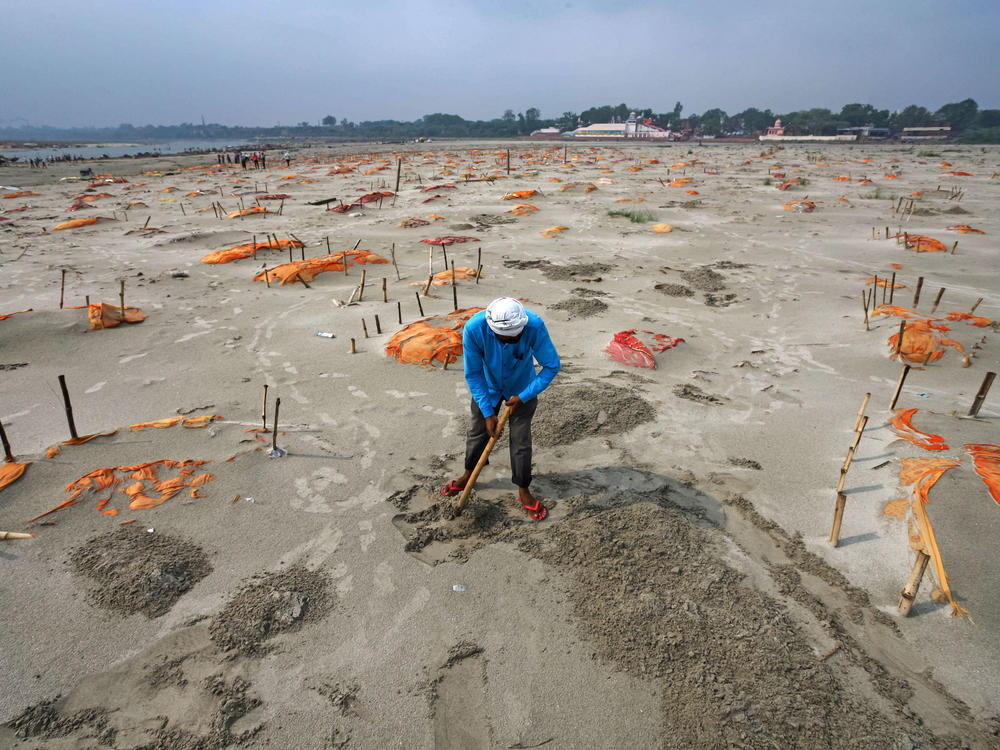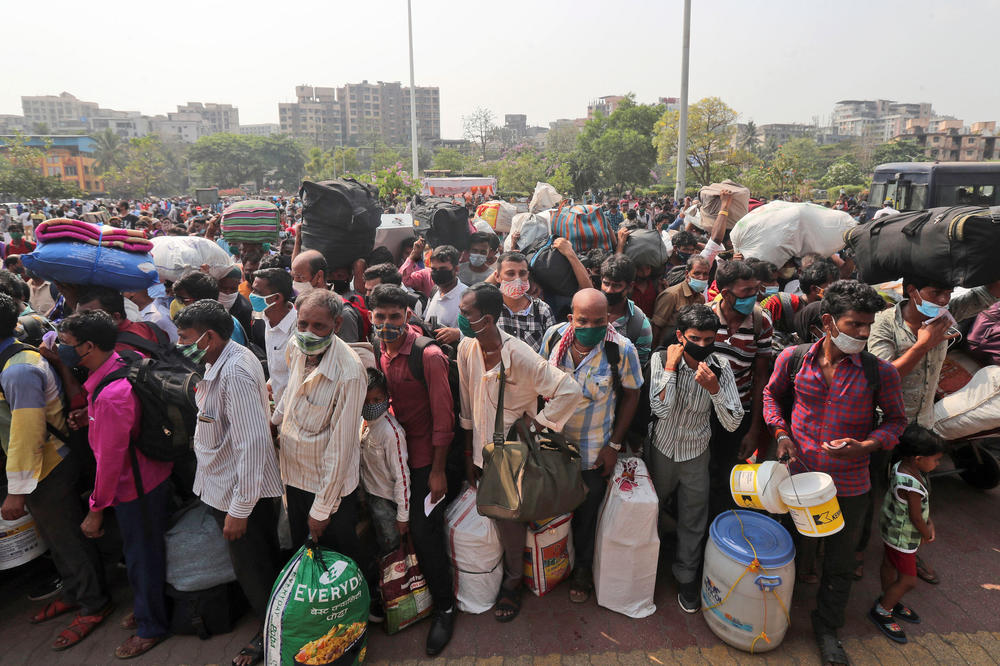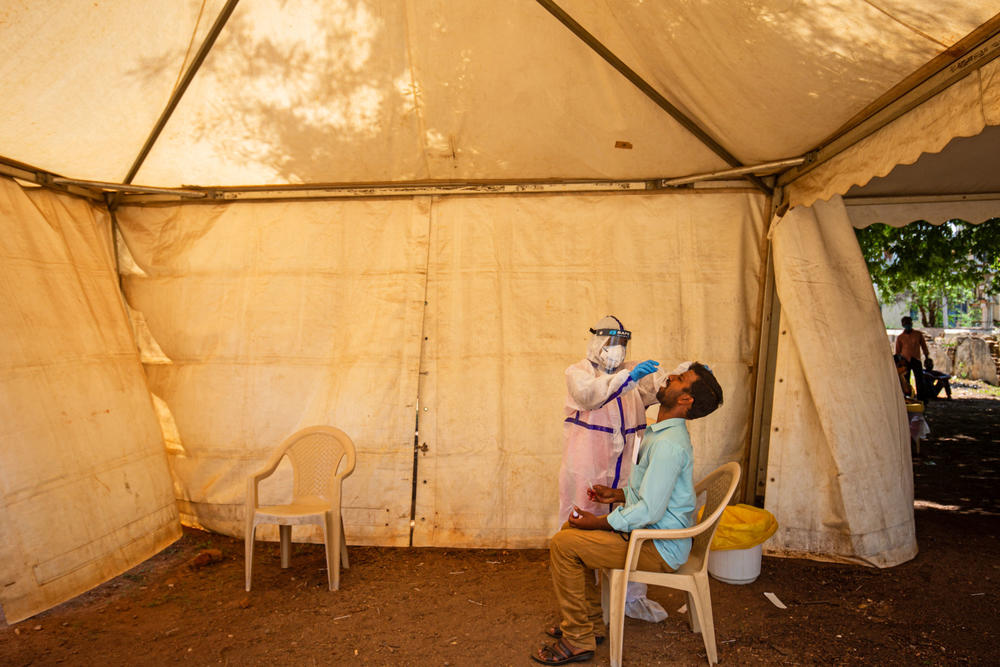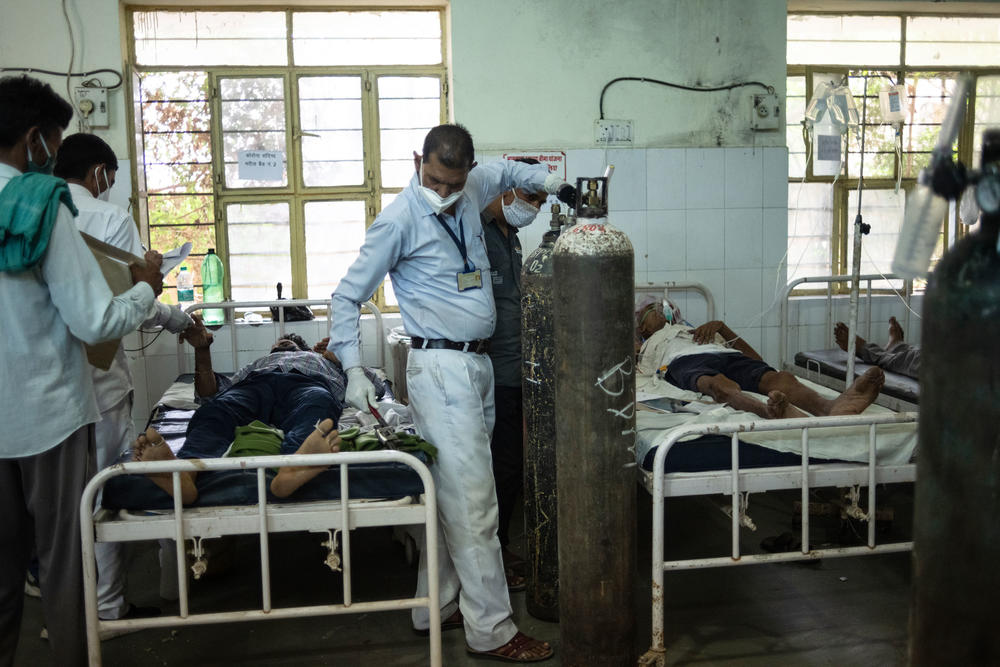Section Branding
Header Content
In Rural India, Less COVID-19 Testing, More Fear — And A Few Ventilators For Millions
Primary Content
MUMBAI, India — Watching horrifying scenes in India's big cities, where COVID-19 patients have been unable to get ambulances, and even the best-equipped hospitals have run out of oxygen, Saurav Kumar shuddered to think what this wave of the pandemic would do to his hometown.
Kumar, a 30-year-old tech worker in New Delhi, grew up in a rural area of the eastern state of Bihar. With a population of more than 100 million, Bihar is one of the country's most populous states and one of its poorest, where the average income is about $600 per year.
Most people he knows back home have never used the internet and don't have access anyway. Kumar worries about how they'll ever manage to book vaccination appointments, which has to be done through the government's buggy CoWIN app and website.
"I was trying to book slots for myself, my wife and my younger brother, and even at 1 a.m. it was limited — everything was getting booked within seconds," Kumar recalls. "If even people like me aren't able to book, what about the people who don't use the internet? They are completely left out."
So Kumar went back to Bihar in mid-April to stay with his grandparents, work from home and try to help his neighbors. He had seen COVID-19's scourge in Delhi, and modelers predicted it would spread to the countryside next. He wanted to help people prepare.
He wasn't the only one traveling home. Millions of India's migrant laborers are originally from Bihar. When Delhi, Mumbai and other big cities imposed pandemic lockdowns in late March and early April, work dried up, and in the subsequent weeks, many Biharis crowded into trains and buses carrying them back to their native villages.
The same thing happened last year, when in March 2020 India imposed the biggest coronavirus lockdown in the world. Afterward, COVID-19 cases spiked in villages where migrants had sought refuge, suggesting they may have inadvertently carried the coronavirus home with them. Kumar worries the same spread may now be happening again.
"Every third household here now has at least one person with COVID-like symptoms, but they are not able to get tested," Kumar says over a crackly phone line from his grandparents' house. "At first it was mostly in the towns, because they have markets. But now it's getting worse, spreading to the small villages too."
For the past month, Kumar has been going door to door with his smartphone, helping people look for hospital beds and register for vaccination appointments.
His district of West Champaran, home to about 4 million people, has just three hospitals — with a total of 210 beds allocated for coronavirus patients — and they're almost all full, he says. Calling around, he's found there are fewer than 10 beds available on any day.
"And if your situation is worse, and you need intensive care or a ventilator or plasma, it's not available at all," Kumar laments. One of the local hospitals does have two or three ventilators, but there are no technicians who know how to use them, he says.
Such shortages were common in rural India even before the pandemic. This is where literacy is low, and many deaths never get registered with the government. But it's where nearly two-thirds of Indians live. So while national daily confirmed coronavirus cases remained below 300,000 (or whatever the cap) on Saturday for the sixth straight day, down from a single-day record over 400,000 two weeks ago, scientists say it's impossible to know whether the world's worst COVID-19 wave has peaked.
The virus may now be moving out of big cities and into rural India — where testing is less widespread and medical care is even more difficult to find. The extent of COVID-19's impact in such areas is difficult to measure.
"Rural India is going to be a mega challenge compared to what we've seen in urban India," Dr. Satchit Balsari, assistant professor of emergency medicine at Harvard Medical School, told an Asia Society panel this week. "So we have to figure out how to take simple measures — all the way from appropriate treatment to vaccination — to have a sound response. When the state leaves a vacuum, we have to step up."
Bodies in the Ganges
There are some early indications the coronavirus wave in rural India has already taken a ghastly toll.
In recent weeks, hundreds of bodies have been found buried in shallow graves along sandy river banks in northern India. Bloated corpses have also been washing up on the banks of the Ganges River in the Indian states of Bihar and Uttar Pradesh. Videos recorded by villagers show wild dogs wading around the bodies, barking. Crows swoop and squawk.
Indian TV crews have descended upon these villages, broadcasting the horrible images to the nation. Many locals are upset about the attention.
"These aren't necessarily COVID victims. In this area, some folks have always immersed their deceased loved ones in the holy river rather than cremating them," says Brij Bihari, the former head of Chausa village, where some of the bodies have been washing up. "They might even be doing this more now, because it's too hot to build funeral pyres."
But in the same village, a local aid worker tells a different story.
"People are scared to tell you the truth," says Abhimanyu Singh, who works in Chausa for a local nonprofit group called Nav Prakriti Jan Kalyan Sansthan, which works to improve access to education and health care for girls from lower income families. "Our local cremation ground used to see one or two funerals a day. Now there are 35 to 40."
Singh says wood vendors have more than doubled the price of firewood used for funeral pyres. People who can afford to cremate their loved ones' remains are still doing so. But many others can't, he says, and so they immerse the body directly into the river.
"It's hard to know who is dying of COVID here and who's not," he adds. "People here rarely seek any medical care."
Fewer doctors and tests
The World Health Organization recommends countries have at least 1 doctor per 1,000 residents. India's health system falls short of that, with about 1 doctor per 1,500 citizens, according to the government.
India's figures for doctors include practitioners of traditional medicine such as ayurveda and homeopathy, who outnumber allopathic (modern, Western-style) doctors by a ratio of nearly seven to one, according to government figures. Public health experts say that while traditional practitioners are important care providers around the world, some in rural India may lack some of the training and equipment to treat COVID-19.
In rural areas, where two-thirds of Indians live and rely almost solely on government hospitals, access is even more dire: the ratio is 1 allopathic doctor to more than 10,000 people — ten times less than what the WHO recommends.
The result, says Dr. Yogesh Kalkonde, a physician and public health expert in a rural part of central India, is that "rural people are used to death."
"It's a part of their life," Kalkonde says. "Death is accepted very easily in many rural areas of India."
Kalkonde treats poor tribal populations in Gadchiroli, a rural district in the state of Maharashtra. He believes the rural COVID-19 caseload is likely even more of an undercount than in urban areas. His patients have long been hesitant to even get tested for the coronavirus. Many are afraid to go anywhere near a hospital, he says.
"Overall awareness is low. There are certain behaviors like mask wearing that are hard to implement," Kalkonde explains. "In rural India, people go by lived experience. So the challenge they feel is, how do they know this is COVID? When should they go to the hospital? People are scared. There are rumors like, 'You're more likely to die if you get hospitalized.' So people are really, really hesitant."
But he says that's slowly changing as the world's biggest COVID-19 wave hits rural India, as people in the countryside see more deaths from the virus firsthand.
In Kalkonde's district of Gadchiroli, population about 1 million, authorities recorded about 10,000 coronavirus infections and 300 deaths in April. While those numbers are likely a vast undercount, because of low testing, they represent a huge spike. The district recorded about the same number of cases in the previous 13 months combined. April also saw triple the number of confirmed deaths from COVID-19 in Gadchiroli, in a single month, compared to the entire period from March 1, 2020, to April 1, 2021. And a state government dashboard shows the district's coronavirus curve still going up.
"The epidemic is unfolding late in rural areas. The number of cases may be going down in big city centers. But it continues to be high in rural areas," Kalkonde says.
That's straining the rudimentary rural health system.
A recent news clip from Kumar's home state of Bihar shows young men wheeling a woman to a hospital on a fruit vendor's cart.
While about 3% of all Indians have received two COVID-19 vaccine doses so far, the rate is likely lower in rural areas, because of the lack of internet connectivity and digital literacy Kumar describes. The CoWIN app for booking vaccinations has only been available in English, which is one of the languages the government conducts business in, but not all citizens speak it. Officials say they plan to add Hindi and 14 regional languages next week.
That still doesn't help Kumar's neighbors, many of whom can't read and don't have smartphones or computers.
"The situation is getting pretty bad here. So many people are sick, and [I estimate] 85% of them are not getting tested," Kumar says. "Vaccination has moved to the back of their minds right now. We are in a battle."
Copyright 2021 NPR. To see more, visit https://www.npr.org.




